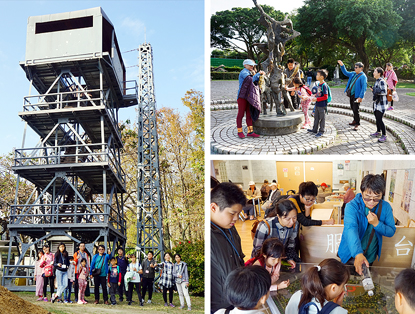Sketch of Archilife Study Tour, December 2019
|
2019年12月份見識之旅縮影  12月份見識之旅活動,於2019年12月14日由呂明澐小姐帶領10位祐生見習生及家長們,進行加蚋仔老台北日常走讀之旅。活動之初,領隊呂明澐小姐提醒本次活動注意事項及觀察重點,先行建立見習生的背景知識。 12月份見識之旅活動,於2019年12月14日由呂明澐小姐帶領10位祐生見習生及家長們,進行加蚋仔老台北日常走讀之旅。活動之初,領隊呂明澐小姐提醒本次活動注意事項及觀察重點,先行建立見習生的背景知識。For the study tour of December 14, 2019, Ms. Lu Ming-yun led 10 ARF interns and their parents to Gala-a to experience the daily life in old Taipei. At the start of the day's activities, team leader Ms. Lu Ming-yun reminded everyone about things to note and what to observe, and gave the interns some background knowledge.  本次行程以南萬華地區為參訪主軸,由高傳棋先生擔任導覽老師。眾人第一站即參訪艋舺龍山寺,高老師首先介紹內部的詩文對聯及建築風華,接著說明種種神蹟使龍山寺成為當地信仰中心,即使歷經多次重建與修葺,在當地居民心中之地位仍屹立不搖,如二次世界大戰期間,若遇有空襲,通常居民會以正殿為避難所,然該次美軍轟炸舊台北城區前夕,居民因不堪蚊蟲煩擾而返家,遂之後正殿雖遭炸毀卻無人受難。隨後走訪西園路上的服飾批發街,由於戰後嬰兒潮與婦女開始投身職場等因素,衣服需求量提高,加上「成衣」概念興起,成衣店陸續開張,形成服飾商圈,全盛時期人潮絡繹不絕,常有服飾店老闆半夜算錢算到睡著。70年代後,成衣紡織廠大量外移,國內市場衰退導致商圈沒落,如何轉型是值得眾人深思的議題。緊接著來到萬華411號公園,高老師講述該處在日治時期主要作為生產輕型飛機之用,並於四周種植樹木與竹林、設置防空洞,以利軍事防護。數十年後,為保留文化資產與自然景觀而設立此公園,一改昔日樹掩護防空洞,防空洞保護人的觀點,由人保存防空洞進而保護深植於防空洞的老樹。 本次行程以南萬華地區為參訪主軸,由高傳棋先生擔任導覽老師。眾人第一站即參訪艋舺龍山寺,高老師首先介紹內部的詩文對聯及建築風華,接著說明種種神蹟使龍山寺成為當地信仰中心,即使歷經多次重建與修葺,在當地居民心中之地位仍屹立不搖,如二次世界大戰期間,若遇有空襲,通常居民會以正殿為避難所,然該次美軍轟炸舊台北城區前夕,居民因不堪蚊蟲煩擾而返家,遂之後正殿雖遭炸毀卻無人受難。隨後走訪西園路上的服飾批發街,由於戰後嬰兒潮與婦女開始投身職場等因素,衣服需求量提高,加上「成衣」概念興起,成衣店陸續開張,形成服飾商圈,全盛時期人潮絡繹不絕,常有服飾店老闆半夜算錢算到睡著。70年代後,成衣紡織廠大量外移,國內市場衰退導致商圈沒落,如何轉型是值得眾人深思的議題。緊接著來到萬華411號公園,高老師講述該處在日治時期主要作為生產輕型飛機之用,並於四周種植樹木與竹林、設置防空洞,以利軍事防護。數十年後,為保留文化資產與自然景觀而設立此公園,一改昔日樹掩護防空洞,防空洞保護人的觀點,由人保存防空洞進而保護深植於防空洞的老樹。Led by Mr. Gao Chuan-chi, the focus of the study tour was southern Wanhua district. The first stop of the tour was Bangka Lungshan Temple. Mr. Gao began by introducing the temple's couplet poems and architectural style. He said many miracles had made Lungshan Temple the center of religious faith in the locality. Despite many reconstructions and repairs, its importance remains unshakable in local residents' mind. For instance, during the Second World War, if there was an air raid, residents would usually seek refuge under the statue of the Bodhisattva in the main temple hall. In one particular instance, on the day before the US army bombed old Taipei City, residents went back to their own homes because of mosquitoes and thus narrowly escaped death when the main temple hall was destroyed by bomb. The next stop of the tour was the garment wholesale street on Xiyuan Road. With the rising demand for clothing due to postwar baby boom and women joining the workforce, and emergence of the "ready-to-wear" concept, garment stores started sprouting up and forming its own business district. In its hay days, throngs of customers visited the stores and store owners often fell asleep in the midst of counting their money past midnight. After the 1970s, there was a mass exodus of garment and textile factories overseas. The slump in domestic demand has caused the decline in the business district, making the issue of transforming the business worth pondering. As everyone arrived at park number 411, Mr. Gao explained that it was used to manufacture light aircraft during the Japanese Occupation. Trees and bamboo plants were planted in the surrounding area, and air raid shelter was constructed, to provide military defense. Over the past several decades, the park was established in the effort to preserve cultural assets and the natural landscape. Instead of the trees providing coverage for the air raid shelter and the air raid shelter protecting people, the situation is now whereby people are preserving the air raid shelter and thus protecting the old trees rooted in the air raid shelter.  中午飯後,高老師表示南萬華舊稱「加蚋仔」,漢人入墾前,原是平埔族的生活範圍,早年水道縱橫,故「加蚋仔」在凱達格蘭語中為沼澤之意,眼前所見的彎曲道路,在早期即古河道經過之處。接著至青年公園導覽,其前身為全台最早的軍用機場,相對於北端的松山機場而有台北南機場之稱,爾後,青年公園附近區域便稱「南機場」。改建成公園後,結合在地人文與休閒運動,逐漸改變南萬華居民的生活型態。行程最後,參訪位於青年公園內部的萬華故事館,透過館內陳設的老照片、史料及影音資訊等展品,讓眾人能深入了解南萬華今昔之變化與當地的民俗小知識。至此,本日活動已近尾聲,大家一起合照留念後搭車返程,並期待於下次見識之旅再相見。 中午飯後,高老師表示南萬華舊稱「加蚋仔」,漢人入墾前,原是平埔族的生活範圍,早年水道縱橫,故「加蚋仔」在凱達格蘭語中為沼澤之意,眼前所見的彎曲道路,在早期即古河道經過之處。接著至青年公園導覽,其前身為全台最早的軍用機場,相對於北端的松山機場而有台北南機場之稱,爾後,青年公園附近區域便稱「南機場」。改建成公園後,結合在地人文與休閒運動,逐漸改變南萬華居民的生活型態。行程最後,參訪位於青年公園內部的萬華故事館,透過館內陳設的老照片、史料及影音資訊等展品,讓眾人能深入了解南萬華今昔之變化與當地的民俗小知識。至此,本日活動已近尾聲,大家一起合照留念後搭車返程,並期待於下次見識之旅再相見。After lunch, Mr. Gao said that southern Wanhua district was originally known as "Gala-a". Before the Han Chinese settled into the area, it was inhabited by the Pingpu peoples. The name "Gala-a" in Ketagalan language means swamp as many waterways cut across the area in the early days. The winding roads seen today were in fact the paths of ancient rivers. The next stop of the tour was the Youth Park, which was formerly Taiwan's earliest military airport. As opposed to Songshan Airport in the northern end, it was known as the South Airport, which is the name given for the area surrounding the Youth Park today. After its transformation into a park, the combination of local culture and recreational sports has gradually changed the lifestyle of the southern Wanhua residents. At the end of the tour, everyone visited the Wanhua Story House inside the park. Through the exhibition of old photos, historical data and video information, everyone had a deep understanding of the changes in southern Wanhua through the times and interesting facts about local customs. At this point, the day's itinerary came to an end. Everyone took a group photo before heading back and looked forward to the next study tour. |

